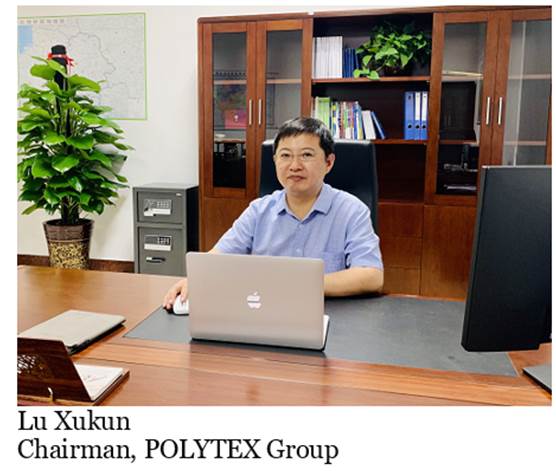As a chemical engineering, procurement, fabrication and construction (EPC) management service and technology providing company, POLYTEX Engineering Group provides complete project, including PET, PBT, PTT, PBAT, PBS, Pa6/Pa66, PLA, PC and other polymerisation lines, solid state polymerisation lines (SSP), regenerative polymerisation plant, coal chemical engineering technology, hydrogen peroxide project, biochemical project, and so on. Chairman Lu Xukun talks about projects, intellectual property, sustainable practices and more.

1. What are the most pressing challenges facing the man-made textile industry today, particularly in terms of raw material availability?
We believe that the most pressing challenges facing the man-made textile industry today, particularly concerning raw material availability, are closely linked to fluctuations in the international oil price climate. Given the volatile international economic environment, shifts in the pricing of raw materials can significantly impact industries like the man-made textile sector, which currently operates on thin profit margins. To mitigate these challenges, companies with sufficient capital should consider strategically stockpiling certain raw materials. Additionally, they could hedge against potential losses through futures contracts, which might offer some financial benefits.
2. What distinguishes POLYTEX’s technology and procedures from other competitors in the textile industry?
Since its inception, POLYTEX has consistently aimed to create distinct products, making the strict control of quality and cost its primary mission. Our advantages are manifold:
• We have a dedicated engineering team that oversees the complete project lifecycle, offering guidance from design through to erection and commissioning.
• POLYTEX is home to a unique R&D centre; the only facility in China capable of running a continuous, multi-function, compatible, multi-product pilot plant. Our R&D team is committed to advancing both equipment and formulations and is always eager to share new technical breakthroughs with our clients.
• We house a self-sufficient equipment manufacturing centre, where critical apparatus such as reactors are conceived and constructed. The incorporation of both fully and semi-automated manufacturing machines ensures the reliability and efficiency of our essential equipment.
• Our self-operated polyester production plant boasts an impressive annual capacity of 420,000 tons. We offer customers comprehensive services that encompass training, operation, management, and testing, amongst other aspects.
This multi-faceted approach ensures that POLYTEX stands head and shoulders above competitors in the textile industry.
3. In which countries have you erected and commissioned projects for manufacturing of synthetic textile raw materials? How has been your experience?
To date, POLYTEX has provided equipment to several countries including China, the United States, India, Russia, Turkiye, South Korea, Vietnam, Thailand, among others. We are also a principal supplier of polyester technology and production lines in these regions.
Reflecting on 15 years of international project experience, my personal takeaway is as follows:
• Prioritising the immediate interests of the client can facilitate the resolution of any issue.
• While commercial efforts are often a numbers game, technical endeavours require meticulous attention.
• Quality remains a universal priority for all customers. Maintaining high standards of quality in our equipment is pivotal, as it not only satisfies existing customers but also attracts new ones.
• Our objective is to ensure that clients who choose POLYTEX experience no regrets. We are dedicated to offering full-cycle services that exceed expectations.
This philosophy has been central to fostering positive relationships and building a strong reputation in the industry.
4. Could you tell us about your team of experienced professionals and their role in the success of POLYTEX?
POLYTEX places the utmost importance on catering to the immediate needs of our clients, with a keen focus on optimising operational costs and ensuring the safety of plant owners. We approach every project as if we were constructing our own facility, leveraging the knowledge gained from past successes to further refine and enhance each new endeavour.
5. How do you ensure that your projects, especially the ones intended for manufacturing textile raw material, are environmentally friendly and energy efficient?
At POLYTEX, every new endeavour is informed by the insights and successes of previous projects. Leveraging our proprietary know-how that encompasses every stage from raw materials to the final product, we meticulously design and evaluate each step of the process. Key to this is a committed approach to reducing water, gas, and electricity consumption. This is achieved by employing motors that are at the pinnacle of energy efficiency and adhering to principles of full automation in design—all while ensuring compliance with stringent safety regulations in both the layout of the plant and the arrangement of equipment.
Furthermore, every detail in the design undergoes rigorous scrutiny and testing through simulation exercises vetted by a team of multiple professionals. Drawing from practical experiences garnered from operating our own manufacturing plant, we continuously monitor and track the performance of all machinery in real-time, facilitating timely responses to any arising issues.
In essence, POLYTEX guarantees environmentally sustainable and energy-efficient projects, a pledge grounded in a harmonious blend of theoretical knowledge and practical expertise.
6. Can you discuss a case where POLYTEX’s unique engineering design reduced the overall project cost and operating costs for a textile raw material project?
Certainly. A prime example would be the second phase of the Weifang Huabao project, a representative case of polyester direct spinning filament manufacturing in China. We undertook comprehensive plant design responsibilities which included, among others, high-temperature medium (HTM) boilers, air pressure systems, circulating water systems, chilled water provisions, and wastewater treatment facilities, alongside overseeing the polyester plant, melt transfer, and spinning utilities.
In addition to these, we implemented tailor-made solutions such as waste fibre utilisation and paper tube reuse, alongside introducing balance cars for short barge operations. These strategies not only upheld the safety performance standards but also amplified the plant’s capacity by 30 per cent. Furthermore, we achieved a POY full roll rate exceeding 98 per cent.
Despite the prevailing downturn in China’s weaving industry, our customer Huabao managed to reap substantial benefits and expanded its weaving capacity, fortifying an unshakeable competitive edge in the market.
7. POLYTEX has been involved in the development of PET, PBT, PTT, PBAT, PBS, Pa6/Pa66, PLA, PC, and other polymerisation lines. How do these projects differ from one another?
POLYTEX excels in the research, development, engineering design, and manufacturing of an array of polymers, with the PET and PBT lines representing just a portion of our ventures. Each polymer type entails distinct product characteristics, calling for unique developmental approaches. Leveraging the expertise of our in-house research and development and engineering teams, we have successfully forged paths in numerous polymer sectors, each bearing its own set of fruitful results.
8. Could you tell us about the single line 400TPD PBT production line orchestrated by POLYTEX and its accolades, including the first prize in the Henan Science and Technology Innovation and the top honour from the 2017 China Coal Industry Department?
POLYTEX set a global benchmark in the PBT industry with the triumphant initiation of the 400TPD single-line PBT production line. As of now, POLYTEX has facilitated the launch of three such plants globally, each boasting the unrivalled feature of exceeding 240TPD PBT single-line production capacity. This undertaking leverages POLYTEX’s exclusive technology to produce PBT chips with a viscosity IV of 1.3, without requiring a viscosity enhancement device, thereby ensuring stable product performance that facilitates seamless spinning and injection moulding. This innovative approach not only curtails investment costs but also minimises consumption levels. The awards attest to the plant’s stellar performance, marked by a successful one-time start-up and years of world-class, uninterrupted operation.
9. POLYTEX has independent intellectual property rights across various fields. How does this benefit your textile raw material projects?
The POLYTEX Group possesses a rich portfolio of intellectual properties, inclusive of innovative technological processes, specially structured equipment, novel catalysts, and numerous unpatented proprietary technologies, such as the pioneering large-capacity PBT plant described earlier. This extensive reservoir of intellectual assets affords us an unparalleled competitive edge in the textile raw material projects, both for our internal operations and for our clients. By adopting these pioneering technologies, our clients can also carve out substantial competitive advantages in their respective markets. Furthermore, the protection afforded by our patented and proprietary technologies ensures client security, fostering significant benefits in the long run.
10. How do you manage the quality control of your projects, and what measures are in place to ensure consistent quality across projects?
At POLYTEX, our strategy for ensuring quality control hinges on a fully automated configuration combined with a deep-rooted experience in automation control strategies. This entails a sophisticated automation instrument system and ultimate process and equipment design, augmented with comprehensive operation training. Such a system significantly diminishes the scope for human error, guaranteeing long-term stable operation of the production equipment and, consequently, maintaining a consistent quality of products. This strategy proves to be advantageous for downstream quality control as well.
11. Can you elaborate on the future of sustainable practices in the textile industry and how POLYTEX plans to contribute to this future?
POLYTEX maintains a vigilant eye on the unfolding dynamics and risks in the global textile industry. Looking ahead, we anticipate a bifurcation in the textile industry where one stratum will be dominated by entities leveraging capital advantage to amass large capacities, while the other will focus on crafting multi-functional or differentiated textile products. POLYTEX remains true to its foundational ethos, continuing to develop multifunctional plants and differentiated products. Currently, we hold a dominant position in several differentiated textile niches, constantly nurturing our competitive edge.
12. Given the impact of technology on every industry, how do you see technology influencing the future of the textile industry and POLYTEX’s role in it?
Undeniably, technology will play a pivotal role in the textile industry’s future, steering it towards increased automation, digitisation, and the incorporation of intelligent technologies. Moreover, the advent of new materials and processes stands to unlock a plethora of opportunities and transformations in the industry. POLYTEX, leveraging years of experience working in these domains, is well-positioned to seize the opportunities that lie ahead, having already secured a foothold in this competitive landscape.





_Big.jpg)




Comments